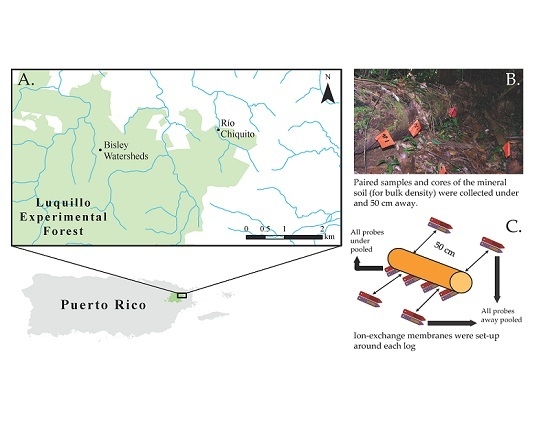Published Date
Forests 2016, 7(8), 168; doi:10.3390/f7080168
Author
For further details log on website :
http://www.mdpi.com/1999-4907/7/8/168
Forests 2016, 7(8), 168; doi:10.3390/f7080168
Author
1
United States Department of Agriculture, Forest Service, International Institute of Tropical Forestry, Jardín Botánico Sur, 1201 Ceiba St.-Río Piedras, San Juan 00926, Puerto Rico
2
United States Department of Agriculture, Forest Service, Northern Research Station, Luquillo 00773-1377, Puerto Rico
†
Deceased.
*
Author to whom correspondence should be addressed.
Academic Editor: Björn Berg
Received: 31 May 2016 / Revised: 19 July 2016 / Accepted: 29 July 2016 / Published: 4 August 2016
(This article belongs to the Special Issue Decomposition of Forest Litter and Its Links to Carbon Sequestration and Nutrients' Dynamics)
Abstract
Decaying wood is related to nutrient cycling through its role as either a sink or source of nutrients. However, at micro scales, what is the effect of decaying logs on the physical, chemical, and biotic characteristics of the soil underneath? We took samples from a 0 to 5 cm depth under and a 50 cm distance away from decaying logs (Dacryodes excelsa and Swietenia macrophylla) at 2 stages of decay, and measured soil temperature, total and available nutrients, and root length in a tropical wet forest. We found decaying wood affected physical, chemical, and biotic properties of the underlying soil. Soil temperature was less variable under the decaying logs than away from the logs. Soil under the decaying wood had fewer roots, and lower NO3− and Mg2+availability than samples collected a distance of 50 cm away from the logs. Tree species and decay stage were important factors defining the effect of decaying wood on the distribution of available nutrients. Ca2+, Mg2+, and K+ levels were higher in the soil associated with the youngest logs, and were higher near S. macrophylla logs. Heavy metals were also higher in the soil located near the younger logs independent of the species; other metal ions such as Al3+ and Fe3+ were higher in the soil associated with D. excelsa and the oldest logs. These results indicate decaying wood can contribute to and generate spatial heterogeneity of soil properties. View Full-Text
Keywords: coarse woody debris (CWD); wood decomposition; soil properties; available nutrients; roots; microbial biomas; tropical forest; Puerto Rico
▼ Figures
This is an open access article distributed under the Creative Commons Attribution License which permits unrestricted use, distribution, and reproduction in any medium, provided the original work is properly cited. (CC BY 4.0).
Scifeed alert for new publications
Never miss any articles matching your research from any publisher- Get alerts for new papers matching your research
- Find out the new papers from selected authors
- Updated daily for 49'000+ journals and 6000+ publishers
- Define your Scifeed now
http://www.mdpi.com/1999-4907/7/8/168






No comments:
Post a Comment